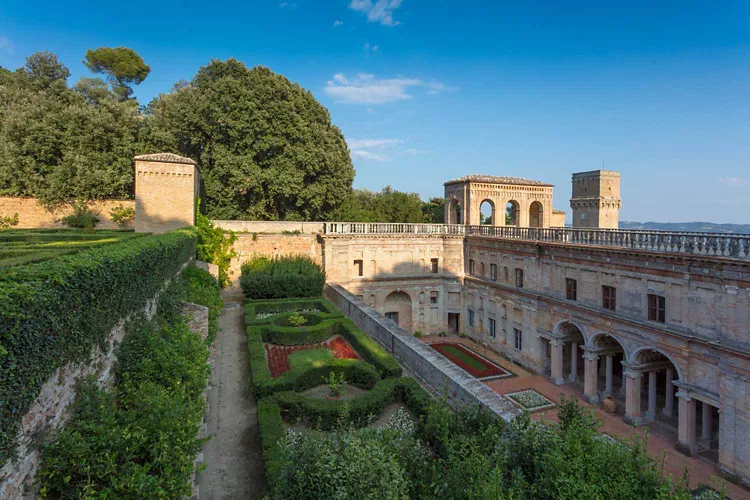This content was automatically translated. View the original text.

Overview
A Renaissance jewel in harmony with the landscape
In the imposing Villa Imperiale in Pesaro, a Renaissance masterpiece, architecture merges with the surrounding nature in an inseparable bond. Surrounded by the greenery of the protected area of the San Bartolo natural park, the building looks today as it was originally conceived by the Sforza family in the 15th century, later enlarged and remodelled in the 16th century by the Della Rovere family. Just 5 minutes from the centre of Pesaro, it is the ideal place for a walk through history.
A bride's gift to her warrior husband
The villa is called Imperiale because the foundation stone was laid by Emperor Frederick III of Habsburg, who was hosted in Pesaro in 1468 by the Sforza family during his trip to Italy for the coronation. The complex that has survived to the present day is the result of an extension carried out in the 16th century at the behest of Duchess Leonora Gonzaga, who gifted it to her husband, the Duke of Urbino Francesco Maria I Della Rovere, on his return from war. These are therefore two separate buildings connected by an open-air corridor: a quadrangular villa with a defensive function which was enlarged and refined by the wing built in the 16th century by the famous Urbino architect Girolamo Genga. As a harmonious unit, it is a place of delight, suitable for the cultured and refined lifestyle of a Renaissance court.
Open spaces for court ceremonies
The 16th-century wing, located on the hill thanks to a system of terraces on four levels, is articulated in various open spaces: loggias, gardens and courtyards, places designed to allow the dukes and their guests to organise all kinds of ceremonies, receptions and shows in the enchanting, fairytale setting of a suburban villa immersed in a forest.
The Renaissance garden occupies a large part of the terraces embellished with geometric flowerbeds made of boxwood hedges sculpted according to the dictates of ars topiaria, interspersed with other species such as laurel, myrtle and rosemary, with citrons, lemons and oranges planted in terracotta pots. In contrast, the upper part of the park has been left to forest. From the highest parts of the terraces, there is a beautiful view of the Foglia river valley, the rolling hills of the Marche region and the peaks of the Apennines.
A wonderful fresco cycle
The sequence of vividly coloured Mannerist-style frescoes commissioned for the Villa Imperiale by architect Genga is remarkable, particularly in the wing reserved for Duchess Leonora and the large rooms of the 15th-century palace. Some of the greatest artists of the time worked at the villa, from Dosso Dossi to Raffaellino del Colle, from Bronzino to Camillo Mantovano.
The Decline and the Rebirth
When the Duchy of Urbino was incorporated into the Papal State in 1631, ownership of the villa passed to the de' Medici family, but it experienced long years of neglect. During the 18th century it accommodated Spanish and Portuguese Jesuit monks in exile, who changed its spaces and decorations. It was only when it was acquired by the Albani Castelbarco family at the end of the 18th century that the villa regained its function as a noble residence. Thanks to decades of restoration work, which allowed the original 16th-century appearance to be recovered and preserved, the villa is now used as a location for ceremonial events, weddings and congresses.
The San Bartolo park, between the hills and the sea
Villa Imperiale is located in the San Bartolo Park, a regional protected area between the green hills of the Marche and a coastal strip characterised by a high cliff overlooking the Adriatic Sea. Completely immersed in greenery, it is surrounded by a farm that organically cultivates centuries-old olive trees. The villa can only be visited in the summer, from June to September, with guided tours for small groups and by appointment.